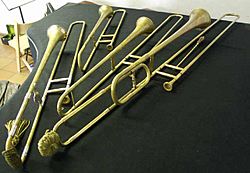Sackbut facts for kids

Sackbuts
|
|
| Classification | Brass |
|---|---|
| Related instruments | |
| Trombone | |
The sackbut is a cool old musical instrument. It belongs to the brass family. People played it a lot during the Renaissance period. This was a time in history from about the 1300s to the 1600s. The sackbut was an early version of the modern trombone. The oldest ones we know about are from the 1500s!
Contents
What is a Sackbut?
The sackbut looks a lot like a trombone. But it has some differences. Its tubes are narrower than a trombone's. It also does not have a water key, a slide lock, or a tuning slide. These parts are found on modern trombones.
How the Sackbut Makes Music
You play the sackbut by buzzing your lips into a mouthpiece. This makes the air inside the instrument vibrate. The sackbut has a special sliding tube. You can move this tube to change the length of the instrument. Changing the length lets you play a full range of different notes. This means it can play every note in a chromatic scale.
Different Sizes and Uses
Sackbuts were made in several sizes. There was a descant (which was rare), an alto, a tenor, and a bass. Each size played different ranges of notes. People often played sackbuts to go along with a church choir. They added a rich, deep sound to the music.
Images for kids
-
"Busaun" (trombone) and various trumpets by different names, from the 1511 treatise by Sebastian Virdung.
-
Sackbut in a fresco by Filippino Lippi in Rome, The Assumption of the Virgin, dating from 1488 to 1493. This is the earliest clear evidence of a double-slide instrument.
-
Trombones in Syntagma Musicum (1614-20), by Michael Praetorius.
-
Marin Mersenne, L'Harmonie universelle (1636).
-
Excerpt from a trombone part from a Picchi canzon (1625). The baritone clef seen here is very common for trombone parts of this era.
-
Trombone on a 1909 headstone, Christ Church, Todmorden
See also
 In Spanish: Sacabuche para niños
In Spanish: Sacabuche para niños









